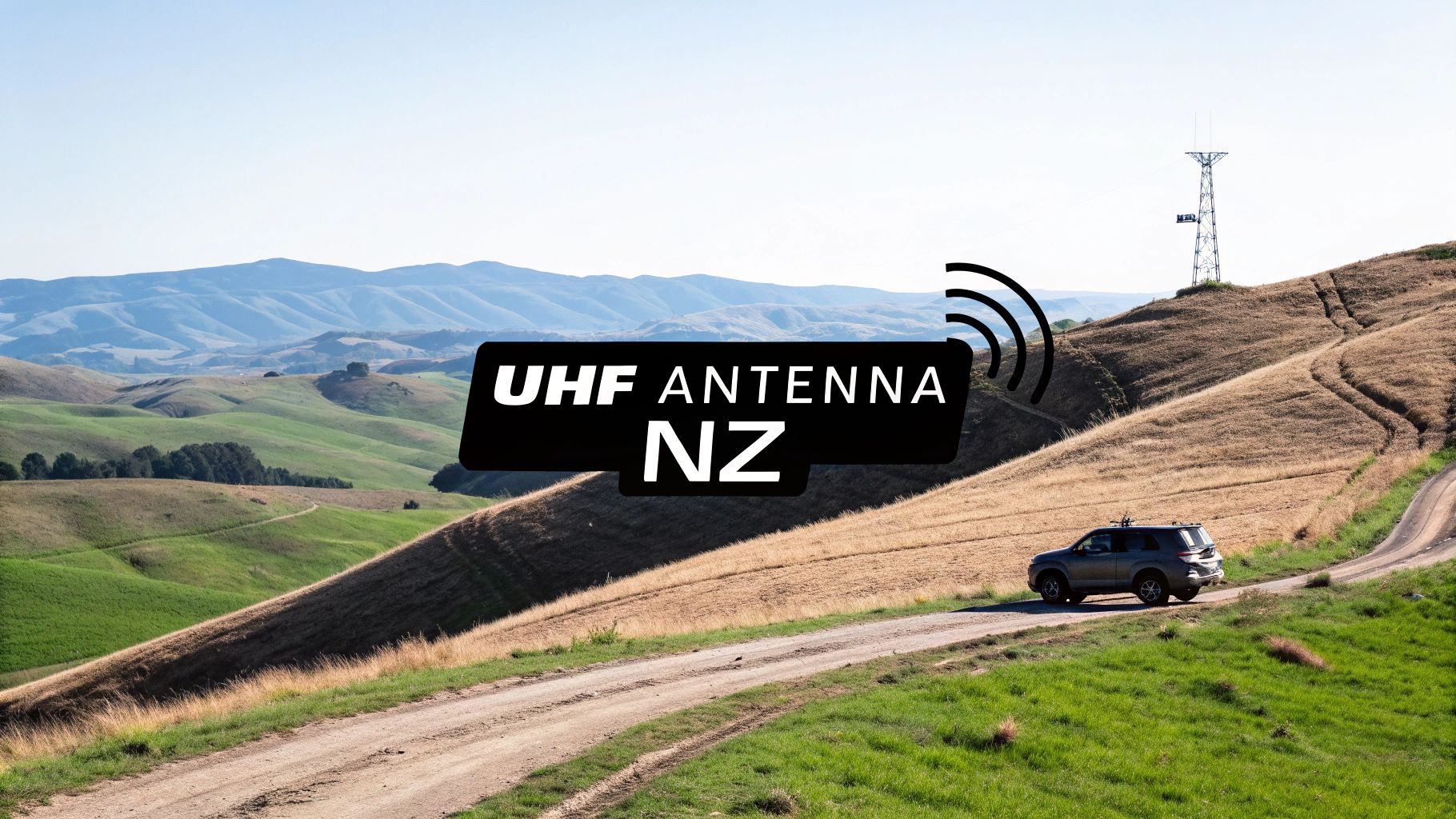Long Range Walkie Talkie NZ: Your Ultimate Guide
When you hear the term "long range walkie talkie nz", it’s easy to picture the massive distances plastered on the packaging.
But getting that kind of range in New Zealand's rugged, varied landscape? That’s a completely different conversation.
True long-range communication isn't about a single number.
It’s a dynamic result of your radio's power, its frequency, the antenna design, and—most importantly—the environment you're standing in.
Specialist communication providers are the best source of product knowledge and advice. They carry an extensive range of solutions to suit your specific needs.
What Long Range Really Means in New Zealand
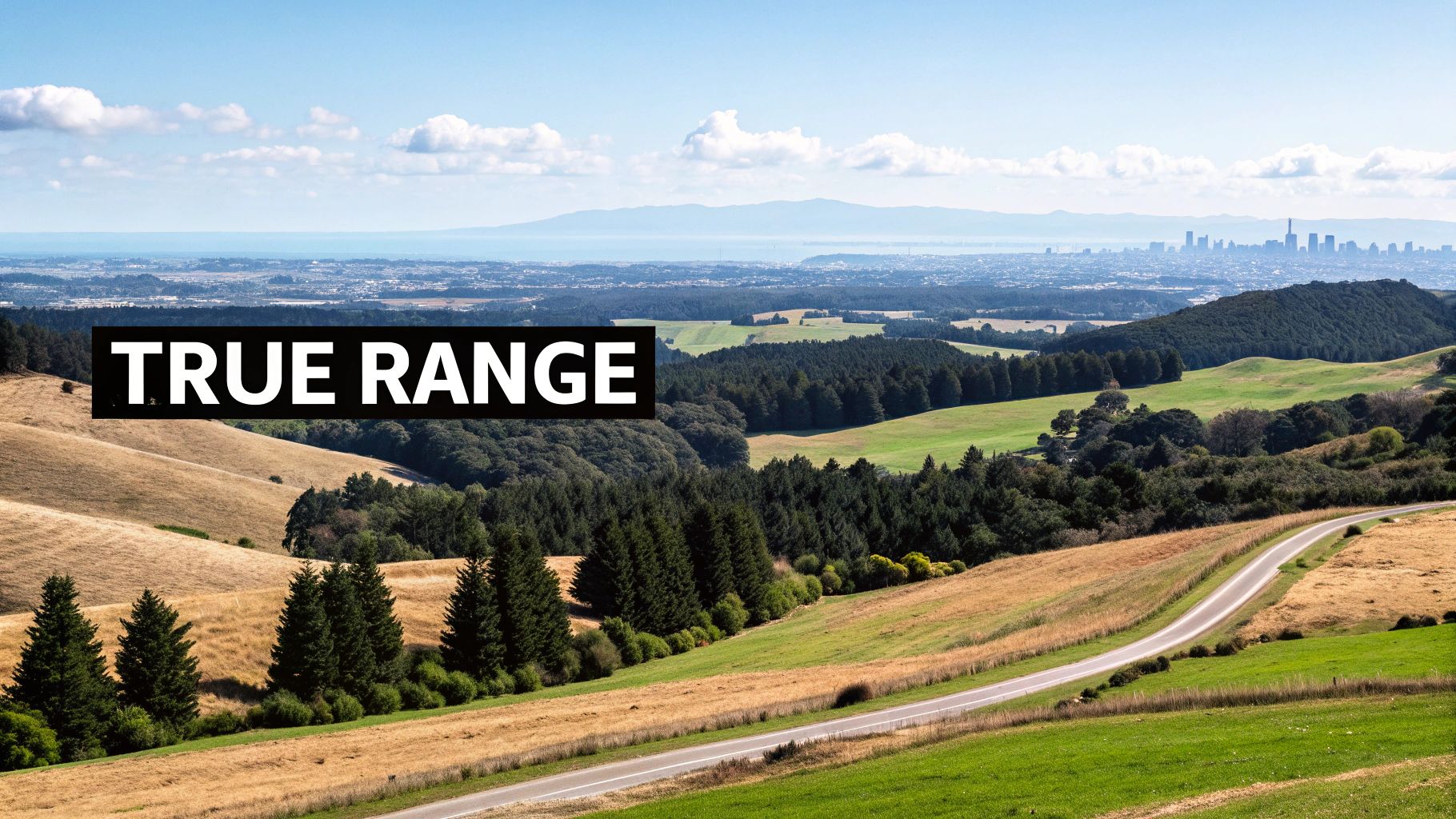
Let's be honest, staring at a box promising a ‘50km range’ can be incredibly tempting, but it's almost always misleading.
That number is typically achieved under perfect, laboratory-like conditions—think flat, open terrain with zero obstructions. It's a scenario you'll rarely, if ever, find across Aotearoa.
The real-world performance of any radio boils down to one simple principle: line-of-sight.
Imagine your radio signal is a laser beam. If a hill, a dense patch of bush, or a city skyscraper gets in the way, that beam gets weakened or blocked entirely. Simple as that.
How the Environment Shapes Your Signal
Trying to get a clear message across a flat Canterbury farm is worlds away from staying in touch in Auckland's CBD or deep within a Fiordland forest.
Your surroundings play the biggest part in determining the actual usable range of any two-way radio.
For most Kiwis, the go-to option is the legal, licence-free UHF CB (Citizen Band) radio service. It's a fantastic starting point for a huge range of activities, from farming to hiking.
A radio's true value isn't the maximum distance on the box, but its ability to deliver a clear, understandable message at the specific distance you need it to work.
Setting Realistic Expectations
Our job here is to help you see past the marketing hype.
Once you understand the core factors that really affect performance, you can pick the right tool for your specific situation—not just the one with the biggest number on the label.
Whether you're coordinating a 4WD convoy, managing health and safety on a worksite, or running a marine operation, having a realistic grasp of your radio's capabilities is absolutely crucial.
This guide will give you the practical knowledge you need to choose wisely and stay connected, wherever you are in New Zealand.
The Science Behind a Strong Radio Signal
Ever wondered why your two-way radio works brilliantly one day but struggles to get a signal the next?
The answer isn't always as simple as you'd think, and it comes down to the physics of radio waves.
Getting your head around the basic science is the key to choosing a walkie talkie that will actually perform when you need it most here in New Zealand.
People often focus on transmitter power, measured in Watts. It seems logical—more power equals more range, right? Well, not necessarily.
Especially in NZ, where public UHF CB radio power is legally capped, raw power isn't the magic bullet. A much bigger piece of the puzzle is the frequency band you're using.
UHF vs VHF Radio Frequencies
The two main players in the two-way radio world are UHF (Ultra High Frequency) and VHF (Very High Frequency).
They might sound similar, but they behave in completely different ways out in the real world.
Think of VHF waves as long-distance runners. They’re fantastic over flat, open country with very few obstacles. This is why they’re the top choice for marine radios or for farmers working across wide-open paddocks.
Their longer wavelength lets them travel further with less power, as long as the path is clear.
UHF waves, on the other hand, are more like nimble parkour athletes. Their shorter wavelength is much better at navigating the cluttered environments we usually find ourselves in.
They can penetrate buildings, bounce around obstacles in dense native bush, and weave through the concrete jungles of our cities. For most land-based activities in NZ, particularly where hills, trees, or buildings are involved, UHF is almost always the better choice for keeping your signal clear.
This infographic gives you a good visual on how different environments and frequencies can impact your communication range.
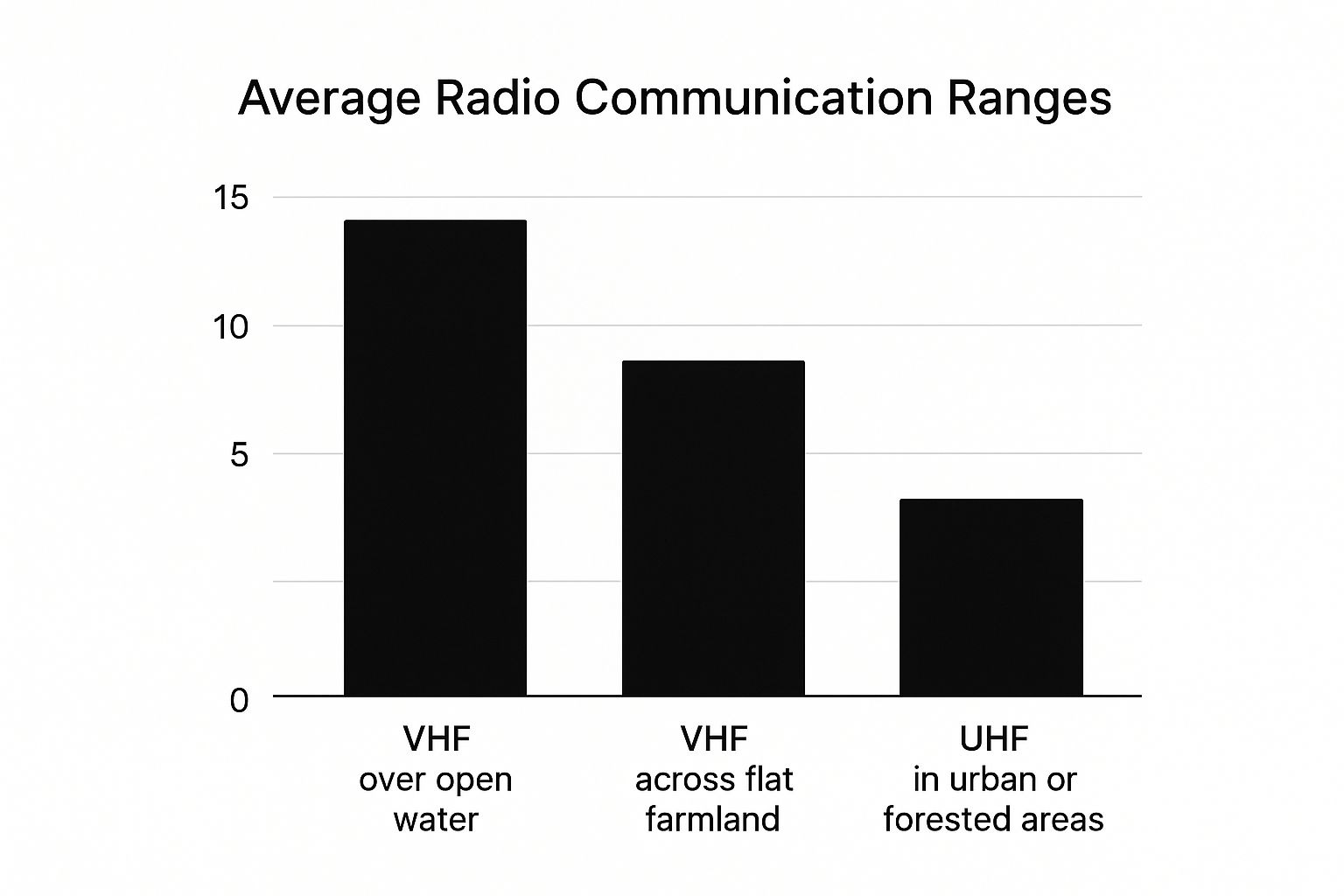
As you can see, VHF shines in wide-open spaces like over water. But for most other situations, UHF's ability to navigate through obstructions makes it more practical, even if its maximum theoretical range is shorter.
To make it even clearer, here’s a quick rundown of how the two bands stack up.
UHF vs VHF Radio Frequencies At a Glance
| Feature | UHF (Ultra High Frequency) | VHF (Very High Frequency) |
|---|---|---|
| Best For | Built-up areas, dense bush, hilly terrain, indoor use | Open terrain, farmland, marine applications (line-of-sight) |
| Obstacle Penetration | Excellent. Shorter waves find paths through and around obstacles. | Poor. Longer waves are more easily blocked by buildings and hills. |
| Signal Range | Shorter range in open areas but more reliable in cluttered ones. | Longer range in open areas with clear line-of-sight. |
| Antenna Size | Shorter, more compact antennas are typical. | Requires a longer antenna for optimal performance. |
| NZ Use Case | The standard for most land-based commercial and recreational use. | Primarily used for marine communication and specific rural operations. |
Ultimately, the choice comes down to where you'll be using your radios. For the varied New Zealand landscape, UHF is generally the more versatile and reliable option for land communications.
Obstacles and Radio Shadows
Physical obstructions are the number one enemy of a good radio signal.
Things like hills, large buildings, and even thick, wet native bush can absorb or reflect radio waves, creating dead zones known as "radio shadows."
A radio shadow is an area where the signal is massively weakened or completely blocked by an obstacle, just like a tree blocks sunlight to create a shadow on the ground.
You have to be realistic about what a radio can do. That means understanding the environment you'll be in.
If you're deep in a valley or surrounded by skyscrapers in the city centre, even the most powerful handheld radio will have a tough time pushing a signal through all that stuff.
This is why line-of-sight is the golden rule of radio communication. The clearer the path between two radios, a stronger and more reliable your signal will be.
Often, the single best thing you can do to improve your range is simply to get to higher ground and out of those radio shadows.
Why Your Antenna Is Your Most Important Upgrade
It's easy to get fixated on transmitter power and all the fancy features, but when it comes to a long range walkie talkie NZ setup, your antenna is the single most critical piece of kit for getting real distance.
Think of it like this: your radio creates the voice, but the antenna is the loudspeaker that actually throws that voice across the landscape.
A poor-quality or mismatched antenna means even the most powerful radio is just whispering into the wind.
This is especially true for handheld radios, which usually come with a small, flexible ‘rubber ducky’ antenna right out of the box.
While they’re convenient and don’t get in the way, this design is a massive compromise on performance. Swapping that standard antenna for a longer, more efficient whip antenna can dramatically boost your signal's reach. The difference is often night and day.
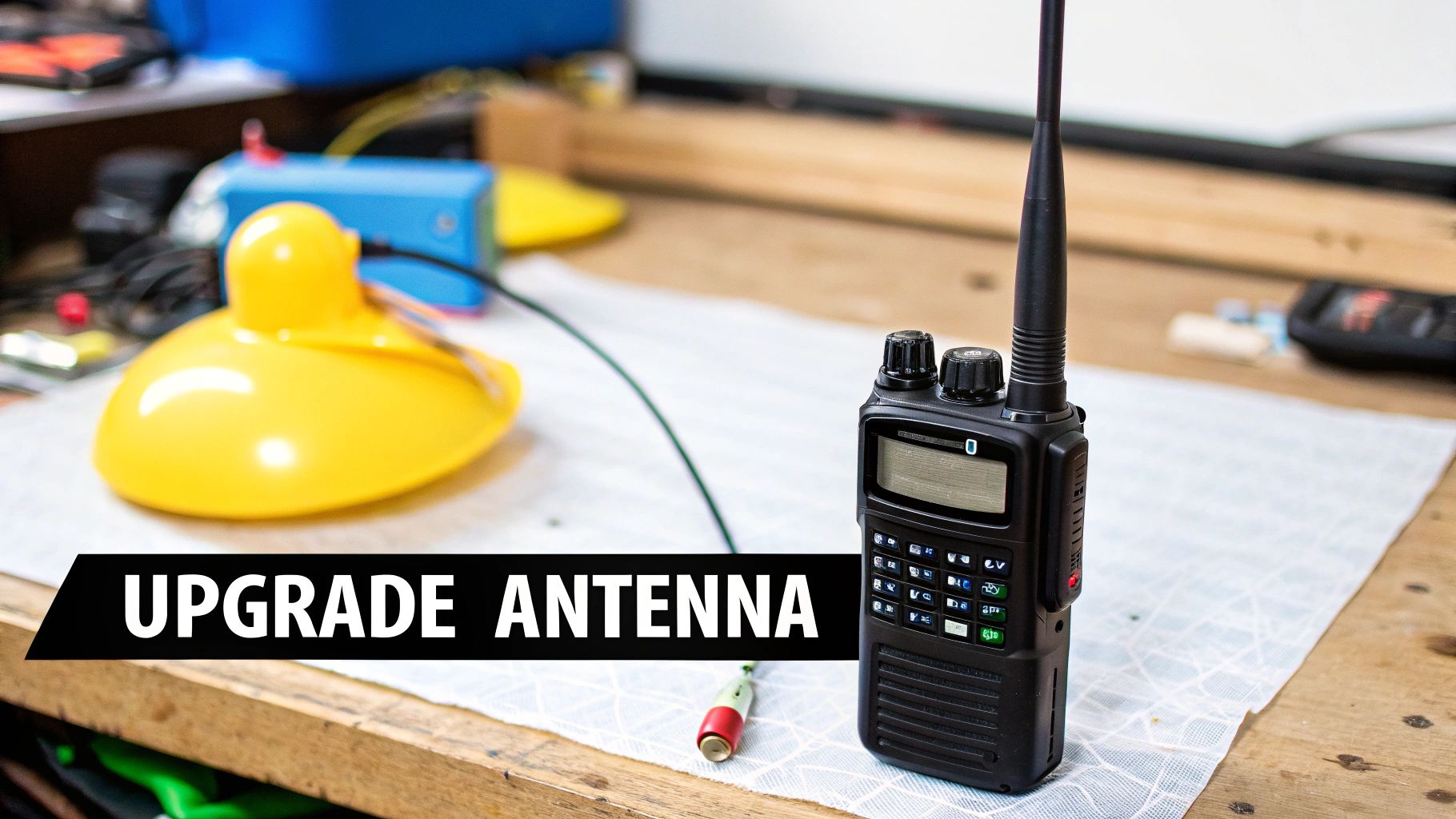
Understanding Antenna Gain
The magic behind a good antenna comes down to a concept called gain, which is usually measured in dBi (decibels relative to an isotropic radiator).
Gain isn’t about creating more power out of thin air; it’s about focusing the existing power much more effectively, just like a lens focuses a beam of light.
- Low-gain antennas (like that standard rubber ducky) radiate your signal in a wide, almost doughnut-like shape. This is actually useful in hilly terrain where you might need to reach signals both above and below you, but the trade-off is that your energy is spread pretty thin.
- High-gain antennas take that doughnut shape and flatten it, concentrating the signal's energy out toward the horizon. This is exactly what you want for reaching distant stations across flat ground or open water, but it can be less effective in steep country where the signal might shoot right over a nearby target.
Choosing the right gain really depends on where you’ll be using your radio most.
If you want to get into the nitty-gritty, we've broken it all down in our detailed article on how antenna gain explained works.
The most effective and affordable path to better range is often not a new radio, but a better antenna. Strategic placement and the right design are essential for overcoming obstacles and maximising performance.
Placement Is Everything
Finally, where you put your antenna is just as important as what antenna you're using.
Height is your best friend in radio communication because it helps you get that all-important line-of-sight to the person you’re trying to talk to.
For a handheld radio, sometimes just holding it higher can make a difference.
For a vehicle, mounting a quality whip antenna on the roof gives you a massive advantage over trying to use a handheld inside a metal box.
The height and the superior ground plane a vehicle mount provides can extend your communication range exponentially, proving that a smart antenna setup is the real secret to unlocking long-range performance.
Handheld Radios vs Vehicle-Mounted Systems
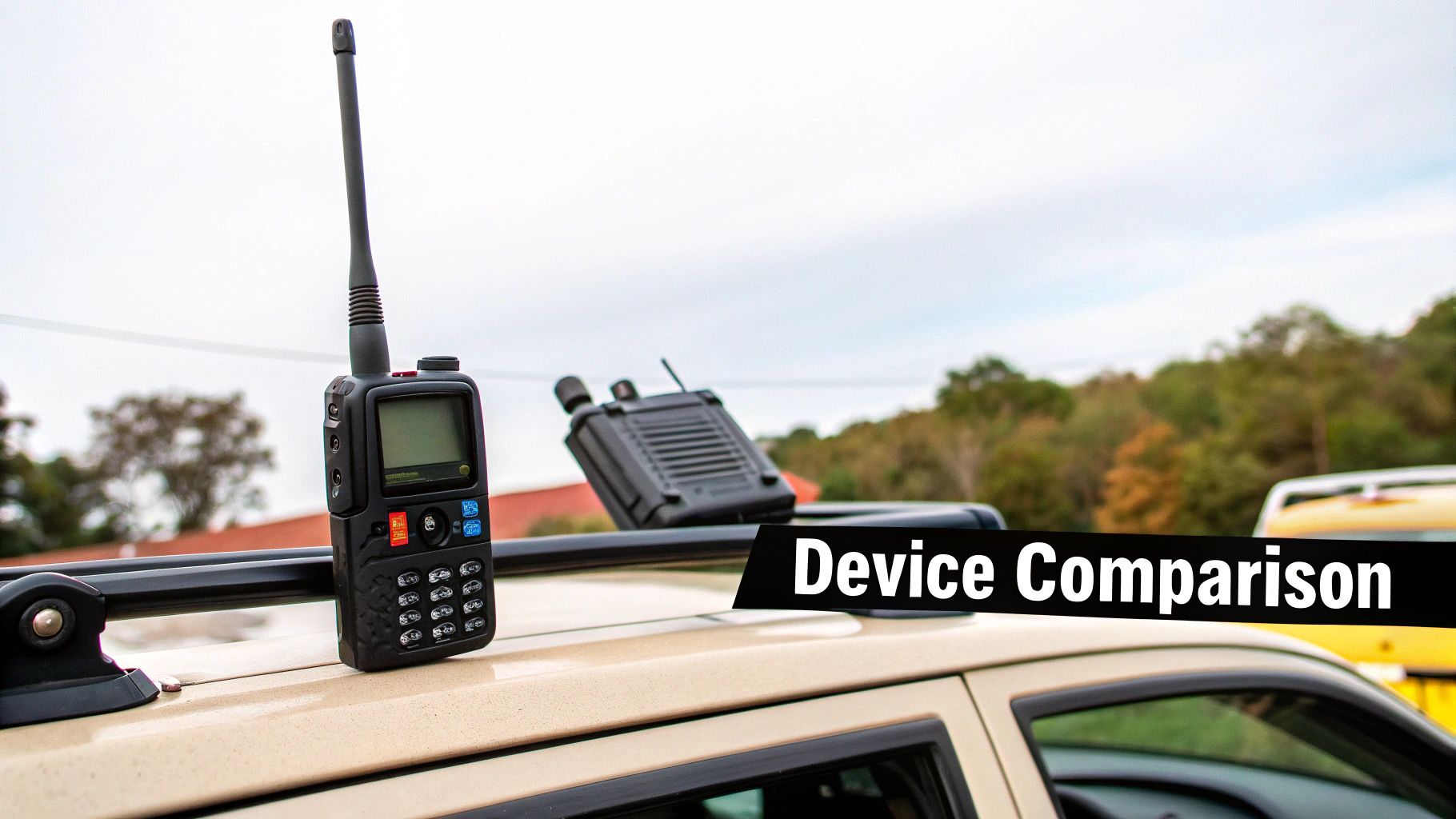
When you're looking at a long range walkie talkie NZ setup, the choice between a handheld radio and a fixed vehicle system goes way beyond just portability.
Sure, handhelds are fantastic for flexibility, but once you put them head-to-head with a vehicle-mounted unit, you start to see some massive differences in performance and range.
A portable handheld radio is the perfect tool for coordinating teams on foot. Think of forestry crews, event security, or workers on a sprawling construction site.
Their biggest advantage is being completely mobile and self-contained, but that portability comes with a trade-off, mainly in power output and antenna performance.
The Power of a Fixed Installation
This is where vehicle-mounted radios really shine. Bolting a radio into your truck or ute gives you a few key advantages that directly translate into talking over much, much longer distances.
- More Juice: Handhelds are typically capped at 5 watts on public UHF CB channels. Many vehicle units can legally push out more power, giving your signal an instant boost right out of the gate.
- A Proper Antenna: This is the real game-changer. A fixed radio connects to a large, efficient external antenna mounted high up on the vehicle.
- The Ground Plane Advantage: Your vehicle's metal roof acts as a 'ground plane'. This conductive surface basically helps the antenna to launch its signal far more effectively than a little handheld antenna ever could.
Using a handheld radio from inside a truck is like trying to shout from inside a sealed room. Pop an antenna on the roof, and you’re giving your signal the height and clear path it needs to travel exponentially further.
Matching the Hardware to the Job
The true strength of a vehicle install is that killer combo of higher power and a properly optimised antenna system.
Mounting a tall whip antenna on the roof of your vehicle gives it the best possible line-of-sight, lifting the signal clear of obstructions like other cars, trees, and general ground clutter.
This kind of setup is absolutely ideal for keeping a 4WD convoy in touch across rugged backcountry or for managing logistics across a huge farm.
While a handheld is essential for the moment you step out of the cab, the vehicle-mounted radio provides the powerful, reliable backbone for communication over serious distances.
In reality, the best systems often use both: a fixed radio in the truck as the central hub, with handhelds for everyone working on the ground.
Analogue vs Digital Radios and Their Impact on Range
Thinking about the leap from analogue to modern digital radios, it’s about much more than a few fancy features.
It’s a fundamental shift in how you experience communication, especially when you’re pushing the limits of your range.
Getting your head around this difference is crucial when choosing the right long range walkie talkie NZ gear, particularly when clear audio is a non-negotiable for health and safety.
Analogue radio signals are a bit like someone shouting down a very long hallway. The further away you get, the fainter their voice becomes, and the more echo and background noise creeps in.
Right at the edge of its range, an analogue transmission turns into a crackly, distorted mess that’s often completely useless.
The Digital Clarity Advantage
Digital two-way radios, like those running on the DMR (Digital Mobile Radio) standard, handle things completely differently.
They convert your voice into clean packets of data. The result? You get perfectly clear, background-noise-free audio right up to the absolute edge of the coverage area. There's no slow fade into static.
When a digital signal can no longer be received, it just drops out. Clean and simple.
What this means in the real world is that at the fringe of your communication distance, a digital signal is still crystal clear and 100% understandable, while an analogue signal would be buried in static. Usable range isn't just about distance; it's about clarity at that distance.
How Digital Enhances Usable Range
While a digital radio's maximum possible range might be similar to its analogue equivalent on paper, its effective or usable range is almost always better.
That’s because the audio quality stays perfect across a much larger slice of its coverage footprint. For anyone working in a noisy factory, on a windy farm, or needing mission-critical clarity, this is a game-changer.
- Error Correction: Digital tech has clever error correction built-in. It can actually rebuild parts of your voice transmission that get lost along the way, making sure the message gets through cleanly.
- Background Noise Suppression: Digital radios are brilliant at filtering out distracting sounds like wind, machinery, or engine noise. All that gets transmitted is your voice.
- Consistent Audio: The volume and quality of a digital message don't dip or waver as the signal strength changes. It provides a much more consistent and professional experience for everyone on the channel.
This massive improvement in audio fidelity and reliability means your messages get heard and understood, even when you're operating at the very limits of your gear.
If you're keen to get into the nuts and bolts, you can learn more about DMR Digital Mobile Radio and see why it’s become the go-to solution for professional operations across New Zealand.
How Radio Networks Unlock Nationwide Communication
So, what happens when your team needs to communicate way beyond the physical limits of any two radios?
When hills, buildings, or sheer distance make line-of-sight a fantasy, you need to tap into the power of a network.
This is the secret to achieving true long range walkie talkie nz performance, extending your team's reach across entire regions or even the whole country.
These professional-grade networks solve the problem of limited range by using some clever infrastructure to grab your signal and fling it over vast distances.
They're built from the ground up for businesses and organisations that simply can't afford to have communication blackspots.
Traditional Repeater Networks
The classic way to stretch your radio range has always been a repeater network.
The best way to think of a repeater is as a powerful signal booster, strategically perched on a hilltop or a tall building.
It listens for a transmission from a low-powered handheld or vehicle radio, then instantly rebroadcasts that same message with much higher power, blanketing a huge area.
This kind of technology is the backbone for heaps of industries right here in New Zealand, including:
- Transport and Logistics: Keeping fleet managers in constant touch with drivers spread across entire regions.
- Agriculture: Providing solid communication across massive farms and rural properties where cell signal is patchy at best.
- Forestry: Acting as a crucial safety lifeline for crews working in remote, challenging terrain.
These networks, often built with rugged gear from brands like Tait or Motorola, are absolutely essential for jobs where standard UHF and VHF signals need a serious kick to cover the ground required.
To get a feel for how these critical systems are engineered for rock-solid reliability, check out our insights on Tait Communications and the role they play.
The Modern Cellular Approach
A newer, and increasingly popular, approach is Push-to-Talk over Cellular (PoC).
These systems give your walkie talkie virtually unlimited range by piggybacking on New Zealand’s existing cellular networks from providers like Spark, One NZ, and 2degrees.
Put simply, as long as you have mobile data, you can talk to your team anywhere in the country.
PoC devices beautifully merge the instant, one-to-many chat of a traditional two-way radio with the nationwide coverage of a mobile phone. You really get the best of both worlds for operations that are spread far and wide.
These are subscription-based services designed for businesses that need dependable, wide-area communication without the massive cost and hassle of building and maintaining their own private repeater network.
For large-scale teams spread across different cities or regions, they offer a level of connectivity that standalone radios just can't touch, making them a very smart, future-proof choice.
Got Questions About Long Range Radios? We've Got Answers
We get asked a lot about how to get the best possible range from two-way radios here in New Zealand. Let's tackle some of the most common questions head-on.
Do I Need a Licence for a Long Range Walkie Talkie in NZ?
That’s the big question, isn’t it? For most people, the answer is no.
If you're using a standard UHF CB (Citizen Band) radio off the shelf, you can operate it without needing a personal licence. These radios are already set up on public frequencies.
However, the moment you need more grunt – like higher power outputs for serious farm work, private frequencies for your business, or a VHF marine radio for the boat – you absolutely will need a licence.
You'll get this from Radio Spectrum Management (RSM). The good news is, if you're setting up a professional radio network, the provider usually handles all the licensing paperwork as part of their service.
Can I Use a Radio from Another Country in New Zealand?
We strongly advise against it, and in most cases, it's flat-out illegal.
Every radio sold and used in New Zealand has to be type-approved to make sure it plays nicely on our specific frequencies and power levels.
Bringing in gear from overseas might seem like a bargain, but it can cause massive interference with crucial networks, including emergency services.
It’s just not worth the risk. Always buy from a reputable NZ-based supplier who knows the local rules inside and out.
What Is the Best Setup for Farming or 4WD Use?
There's no single "best" radio for everyone, but for rugged rural or off-road use, a vehicle-mounted UHF CB radio is tough to beat. The key is to pair it with a high-gain external antenna.
This combination gives you the maximum legal power and a far superior antenna system, which is exactly what you need to punch a signal across large properties, rolling hills, and dense bush. Then, you can use handheld radios for when you're out of the cab.
Think of the vehicle unit as your powerful base station, keeping everyone connected, while the portables give your team on the ground the freedom to move around.
At Mobile Systems Limited, our team lives and breathes this stuff. We can help you sort through the licensing, pick the perfect antenna, and design a radio setup that’s built specifically for what you do.
Discover the right radio gear for your operation at Mobile Systems Limited
